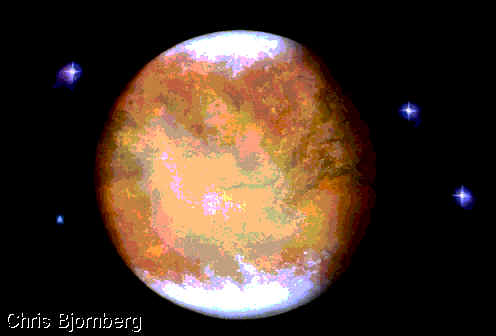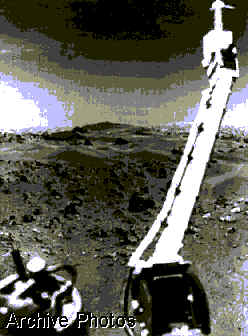|
|
|

Mars, planet in the solar system, named for the Roman god of war. It is the fourth planet from the sun and the third in order of increasing mass. Mars has two small, heavily cratered moons, Phobos and Deimos, which some astronomers consider asteroidlike objects captured by the planet very early in its history. Phobos is about 21 km (about 13 mi) across; Deimos, only about 12 km (about 7.5 mi).
Appearance from Earth
When viewed without a telescope, Mars is a reddish object of considerably varying brightness. At its closest approach to earth (55 million km/34 million mi), Mars is, after Venus, the brightest object in the night sky. Mars is best observed when it is at opposition (directly opposite the sun in earth's sky) and also at its closest distance from earth. Such favorable circumstances repeat about every 15 years when the planet comes to perihelion (its closest approach to the sun) almost exactly at opposition. The last perihelic opposition occurred in 1971.
Through a telescope Mars can be seen to have bright orange regions and darker, less red areas, the outlines and tones of which change with Martian seasons. (Because of the tilt of its axis and the eccentricity of its orbit, Mars has short, relatively warm southern summers and long, relatively cold southern winters.) The reddish color of the planet results from its heavily oxidized, or rusted, surface. The dark areas are thought to consist of rocks similar to terrestrial basalts, the surfaces of which have been weathered and oxidized. The brighter areas seem to consist of similar but even more weathered and oxidized material that apparently contain more fine, dust-sized particles than do the dark regions. The mineral scapolite, relatively rare on earth, seems widespread; it may serve as a store for carbon dioxide (CO2) in the atmosphere.
*(surface of Mars)*
Observation by Spacecraft
The most detailed knowledge of Mars has come from six missions carried out by unpiloted U.S. spacecraft between 1964 and 1976. The first views of Mars were obtained by Mariner 4 in 1964, and further information was gained by the flyby missions of Mariners 6 and 7 in 1969. The first Mars orbiter—Mariner 9, launched in 1971—studied the planet for almost a year, giving planetary scientists their first comprehensive global view of the planet and the first detailed images of its two moons. In 1976 two Viking lander craft touched down successfully on the surface and carried out the first direct investigations of the atmosphere and surface. The second Viking lander ceased operating in April 1980; the first lander worked until November 1982. The Viking mission also included two orbiters that studied the planet for almost two full Martian years. The Soviet Union in 1988 sent two probes to land on the moon Phobos; both missions failed, although one relayed back some data and photographs before being lost to radio contact.
Atmosphere
The Martian atmosphere consists of carbon dioxide (95 percent), nitrogen (2.7 percent), argon (1.6 percent), oxygen (0.2 percent), and trace amounts of water vapor, carbon monoxide, and other noble gases. The average pressure at the surface is near 4.6 torrs, which is 0.6 percent that on earth and equal to the pressure at a height of 35 km (22 mi) in earth's atmosphere. Surface temperatures vary greatly with time of day, season, and latitude. Maximum summer temperatures may reach 290 K (63° F), but average daily temperatures at the surface do not exceed 240 K (-27° F). Due to the thinness of the atmosphere, daily temperature variations of 100° C (180° F) are common. Poleward of about 50° latitude, temperatures remain cold enough (less than 150 K/-189° F) throughout winter for the atmosphere's major constituent, carbon dioxide, to freeze out into the white deposits that make up the polar caps. The total atmospheric pressure on the surface fluctuates by about 30 percent due to the seasonal cycle of the polar caps.
The amount of water vapor present in the atmosphere is extremely slight and variable. The concentration of atmospheric water vapor is highest near the edges of the receding polar caps in spring. Mars is like a very cold, high-altitude desert. Surface temperatures are too cold and surface pressures too low for water to exist in the liquid state in most places on the planet. It has been suggested, however, that liquid water may exist just below the surface in a few localities.
At certain seasons, some areas on Mars are subject to winds strong enough to move sand on the surface and to suspend dust in the atmosphere. A major weather event occurs in the southern hemisphere between late spring and early summer when Mars is near perihelion and the heating of southern equatorial latitudes is most intense. Dust storms begin to form, and some reach global proportions, obscuring the planet's surface for weeks or even months. The dust entrained in these clouds, is very fine and takes a long time to settle.

For more information on Mars, Please visit the following webistes:

[Hit Counter]
